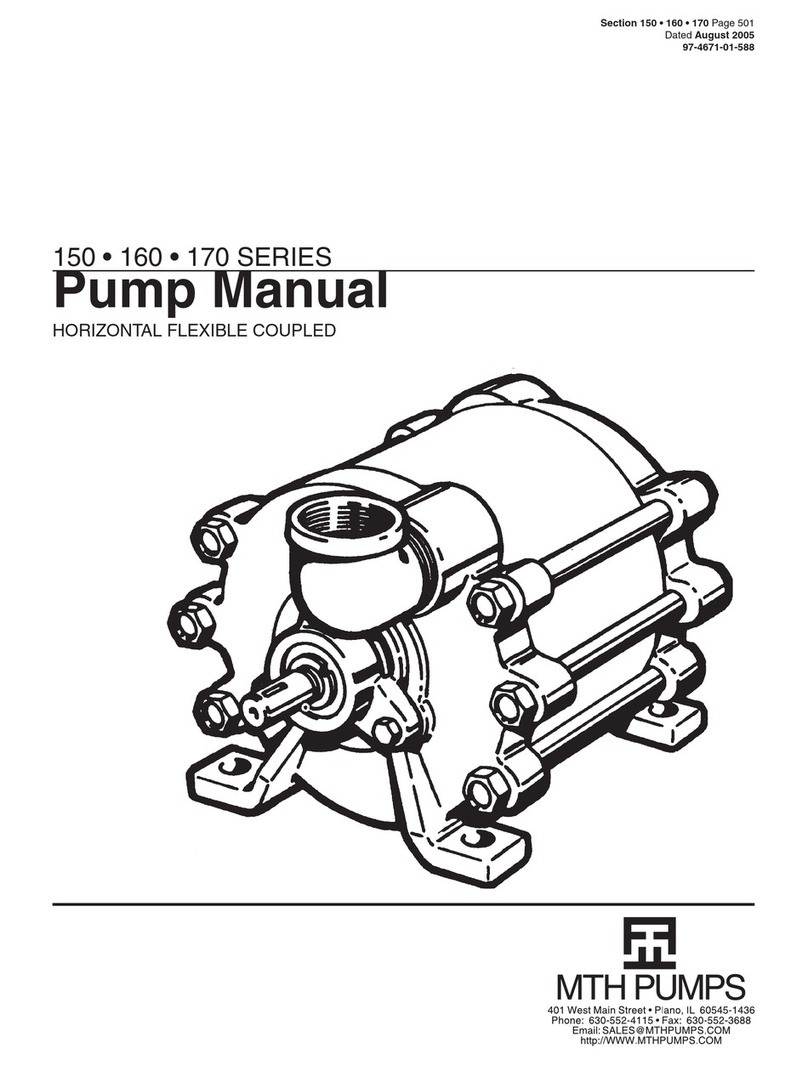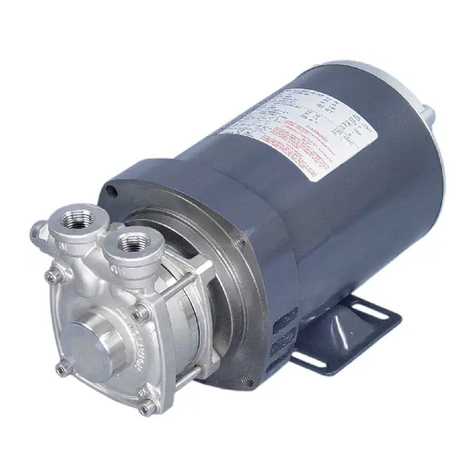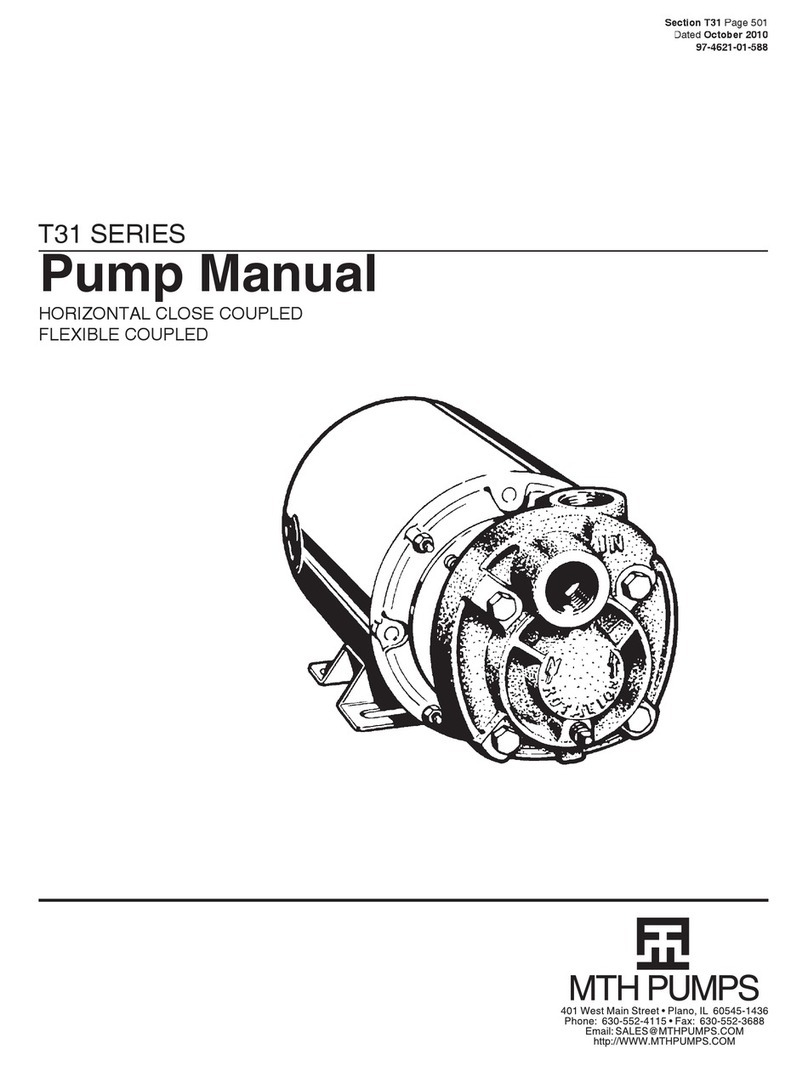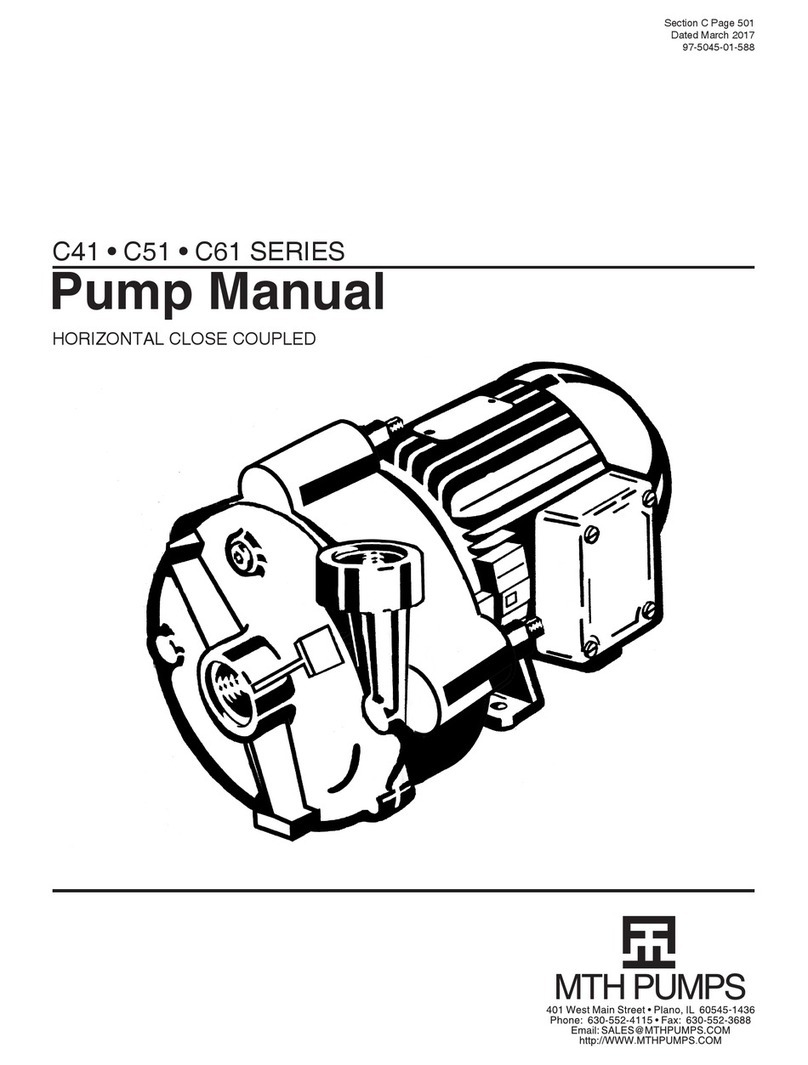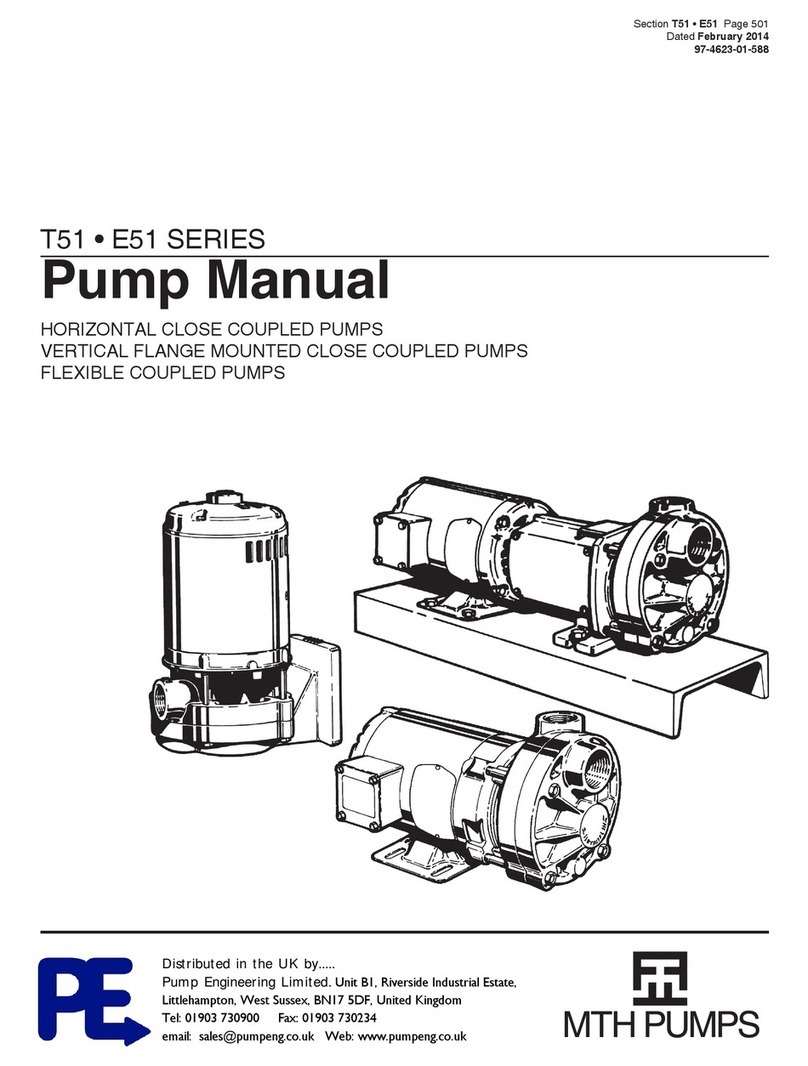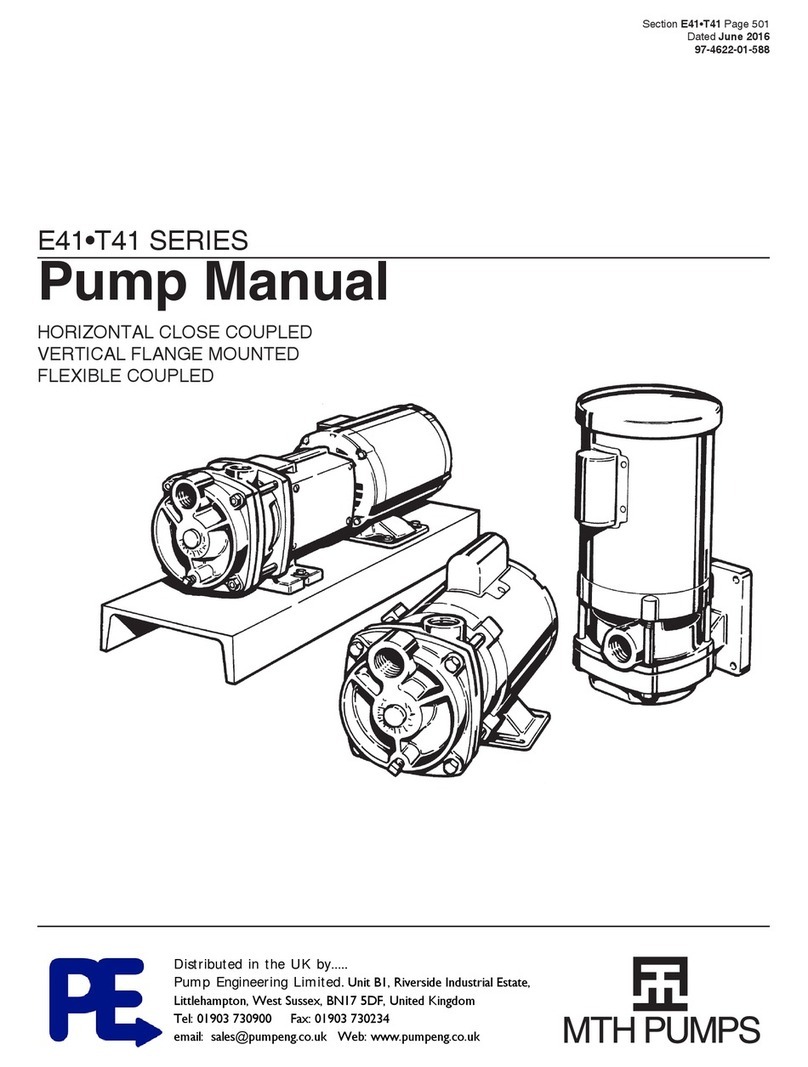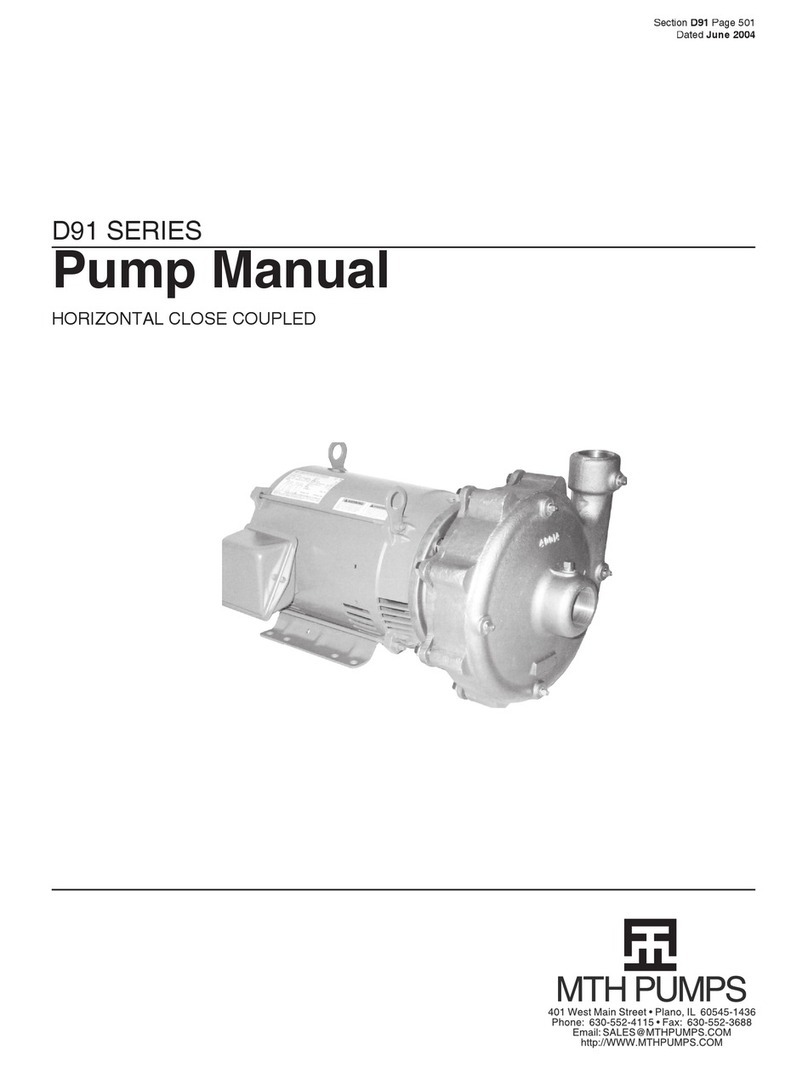
T31 SERIES
General Instructions
CLOSE COUPLED PUMPS
FLEXIBLE COUPLED PUMPS
A. Inspection of Equipment
B. Storage
C. Placing Stored Pumps Into Service
D. Application Considerations
E. Recommended Spare Parts
When properly installed and given
reasonable care and maintenance, re-
generative turbine pumps should operate
satisfactorily for many years. Because of
the high differential pressures expected
in a regenerative turbine pump, close
running clearances are used to reduce
internal losses. Abrasive particles, even
microscopic ones in high enough concen-
trations can open up the close clearances
between internal cavities. For critical
services it is recommended that you keep
an identical pump for stand-by use.
1A Inspection of Equipment
Immediately upon receipt of the shipment,
inspect the equipment for damage or
missing components. Check the shipping
manifest and report any damage or short-
age to the Transportation Company’s local
agent. Inspect the crate and any wrapping
material before discarding. Parts or acces-
sories are sometimes wrapped individually
or fastened to the skid.
Put the instructions that came with the
shipment in a safe place where they will
be available to those who will be using
them for installation and service.
1B Storage
If the pump is to be stored before use, it
should be inspected as described in 1A,
re-crated and stored in a dry location.
Standard shipping containers are not suit-
able for outdoor storage. In some areas,
it may be necessary to cover the pump’s
exterior surface with oil or other rust
inhibiting coating. All units are tested at
the factory with a water/corrosion inhibitor
solution, some of which will remain inside
the pump upon receipt. If units are ushed
out prior to storage, this inhibitor will be
removed and proper care must be taken
to prevent product deterioration from
improper storage.
For storage beyond 30 days, a corrosion
inhibiting protective uid should be added
to the internal pump cavities. Fluids used
in the pump should be selected for com-
patibility with pump materials. This is very
important when optional seal and gasket
materials have been used. Protective
caps on the inlet and outlets should also
be used. Caps alone are not sufcient
protection.
1C Placing Stored Pumps Into
Service
Special care must be taken when placing
stored pumps into service. First clean
the outside and ush out the inside with
a process compatible uid. Try to turn
the pump using the coupling or shaft. On
close coupled units, access to the shaft is
between the pump and motor. A vise grip
or other plier type gripping device may be
used directly on the shaft. Applying torque
to the motor fan blades is not recom-
mended. If the impeller does not break
loose immediately, ll the pump with a
process compatible uid and try again in a
few hours.
If this fails, loosen only the pump cover
thru bolts clamping the assembly together,
one full turn, no more. Fill the pump
with uid. Apply torque, 50 foot pounds
maximum, to the shaft. The pump should
turn before 50 foot pounds is reached.
If you are successful at breaking loose
the unit, continue turning the pump while
re-tightening the thru bolts to their original
positions.
If the unit still won’t turn over, DO NOT
apply further force. Refer to the Disassem-
bly/Reassembly Instructions in Section 5
to determine the cause of the problem.
1D Application Considerations
1D1 Electrical Wiring
All electrical equipment and wiring should
conform to Local and National Electrical
Codes. Use the motor manufacturer’s
instructions for connecting the motor. Note
the correct rotation and wiring diagrams
on the assembly. Make sure the motor
rotation and speed matches that required
for the pump. When making electrical
connections to motors provided with
threaded stud electrical terminals, the
recommended torque should be 13-16
inch-lbs. Applying torque in excess of this
range may cause damage.
1D2 Construction Materials
While it is reasonable to assume that
good judgment has been used in selecting
all the materials in the pump for compati-
bility with process uids, actual conditions
sometimes vary from original expec-
tations. Also, typical material selection
charts do not consider all the temperature,
pressure, and uid variables. The custom-
er’s engineer should be consulted for nal
judgment on the best materials for critical
process applications.
1D3 Valves
The rst valve to be considered for a
regenerative turbine pumping system
might be a pressure relief valve. Because
this type of pump has a horsepower
requirement similar to that of a positive
displacement pump (constantly rising
along with a pressure increase) a relief
valve can be effectively used to limit
horsepower. This is helpful when a
non-overloading motor is specied. It can
be of critical importance if the system ow
rate can vary widely. There are almost no
circumstances where a ow modulating
valve will work successfully in a regener-
ative turbine pumping system. The steep
pumping characteristic, typical of these
pumps, produces very large pressure
changes with small variations in ow rate.
As a result, the modulating ow from the
valve introduces sharp pressure shock
waves that shorten pump life and may
cause damage in other pieces of equip-
ment in the system.
If a shutoff valve is necessary in the
suction line, use a gate, ball, buttery,
or other full port valve. Globe or other
ow restricting valves can in some cases
reduce pump ow or increase chances of
cavitation.
A swing check valve is recommended in
the suction line even when the pump inlet
is only slightly higher than the uid source.
It should be the same size as the pump
inlet or sized based on reasonable uid
friction losses.
A foot valve is recommended when lifting
uid from a sump. This will save wear and
tear on any pump, even those equipped
with self priming equipment.
A Y-Strainer is recommended immediately
ahead of the pump on any newly con-
structed system. This is advisable due to
the probability that foreign material large
enough to damage pump clearances may
remain even though the piping has been
ushed.
Valves in the outlet piping of a regen-
erative turbine pump should always be
open as far as possible when the pump is
started. This will reduce the start-up load
on the pump and motor. Never start the
pump with the discharge valve closed.
Inlet valving should be open when starting
any pumping system. Without some uid
in the pump, it can gall and lock up im-
pellers. Violent pump failure will result
from continued operation with the inlet
valve closed.
1D4 Priming
Regardless of whether self-priming
equipment is used or not, always ll the
pump and vent it of air for best seal and
pump life. Under most circumstances,
regenerative turbine pumps can be made
to self-prime as long as a small amount
of uid can be recirculated through the
impeller and the uid doesn’t heat up
noticeably.
1D5 NPSH (Net Positive Suction Head)
The NPSH required varies with every
size and capacity of pump. The NPSH
required by your unit can be obtained from
the performance curves or from your MTH
representative.
If the NPSH available is not equal to or
greater than that required by the pump,
it must be increased or a different pump
1.
Page 502
